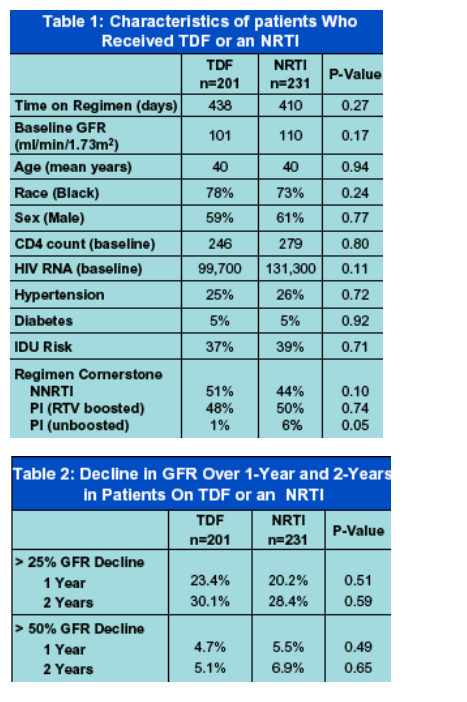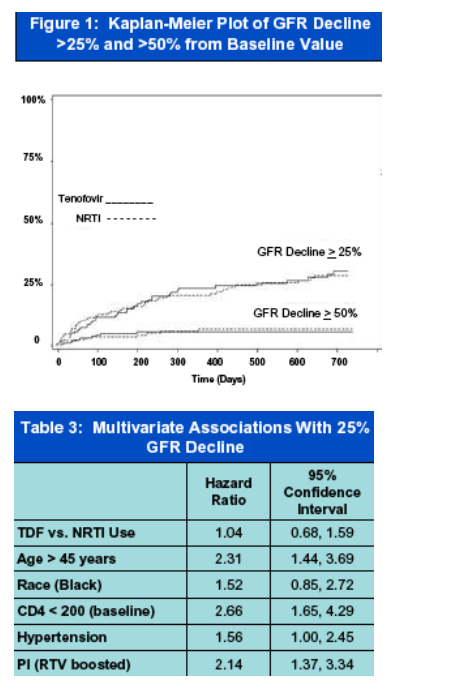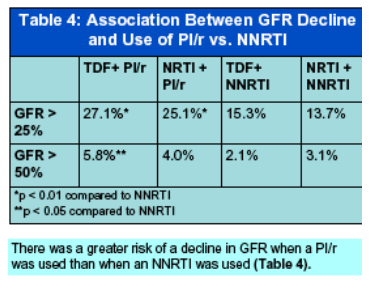 |
 |
 |
| |
Renal Function after Use of Tenofovir as Part of the Initial ART Regimen
|
| |
| |
Reported by Jules Levin
ICAAC/IDSA Oct 28 208 Wash Dc
Richard D. Moore, MD and Joel E. Gallant, MD
Johns Hopkins University - Baltimore, Maryland USA
Tenofovir DF (TDF) is excreted renally via a combination of glomerular filtration and active tubular secretion. TDF has an excellent safety profile in clinical trials in antiretroviral (ART) -naive individuals.
However, observational studies suggest that TDF is associated with renal toxicity, principally in patients who are ART-experienced at time of TDF start. Most cases have occurred in patients with underlying systemic or renal disease.
We wished to determine if TDF is associated with renal dysfunction when part of an initial ART regimen in ART-na´ve patients in clinical practice.
AUTHOR CONCLUSIONS
A modest decline in GFR was observed among antiretroviral-na´ve patients starting BOTH TDF and NRTI as part of their first antiretroviral regimen.
Our results emphasize the importance of having a control group that receives an alternative NRTI. Without an NRTI control group, a decline in renal function could have been attributed to TDF.
Similar to data from randomized clinical trials, our results support the use of TDF as part of the initial antiretroviral regimen. Our data also suggest that GFR should be monitored more closely in older patients, those with CD4 counts< 200 cells/mm3, when hypertension is present, and when a PI/r is used.
METHODS
Study Sample:
HIV-infected patients receiving care in an urban HIV primary care clinic in Baltimore, Maryland.
Inclusion Criteria:
(1) ART na´ve,
(2) Estimated GFR > 50 ml/min/1.73m2,
(3) Initiated TDF or any NRTI as part of a ART regimen after January 1, 2002
Definitions:
Glomerular Filtration Rate (GFR) was calculated using the MDRD equation.
Baseline GFR : Average of the 2 GFR obtained closest to start of treatment.
Change in GFR: Calculated from average of maximum Cr for each subject and next Cr obtained. If no on-treatment Cr measurement after maximum Cr, then
maximum Cr and Cr immediately prior to maximum were averaged. Two values were used to minimize regression to the mean.
Analysis:
We calculated the time to a 25% and 50% decline in GFR from the baseline level
(confirmed by 2 measures of serum creatinine) out to a maximum of 2 years after starting TDF or an NRTI.
We used right-censored Kaplan-Meier methods to determine time to GFR decline. Censoring occurred at discontinuation of the baseline therapy, leaving care, or at 2 years. The log-rank test was used to determine statistical significance.
Multivariate analyses was performed using Cox proportional hazards regression to assess therapy (TDF vs. alternative NRTI) and other demographic and clinical factors associated with GFR decline.
RESULTS



|
| |
|
 |
 |
|
|